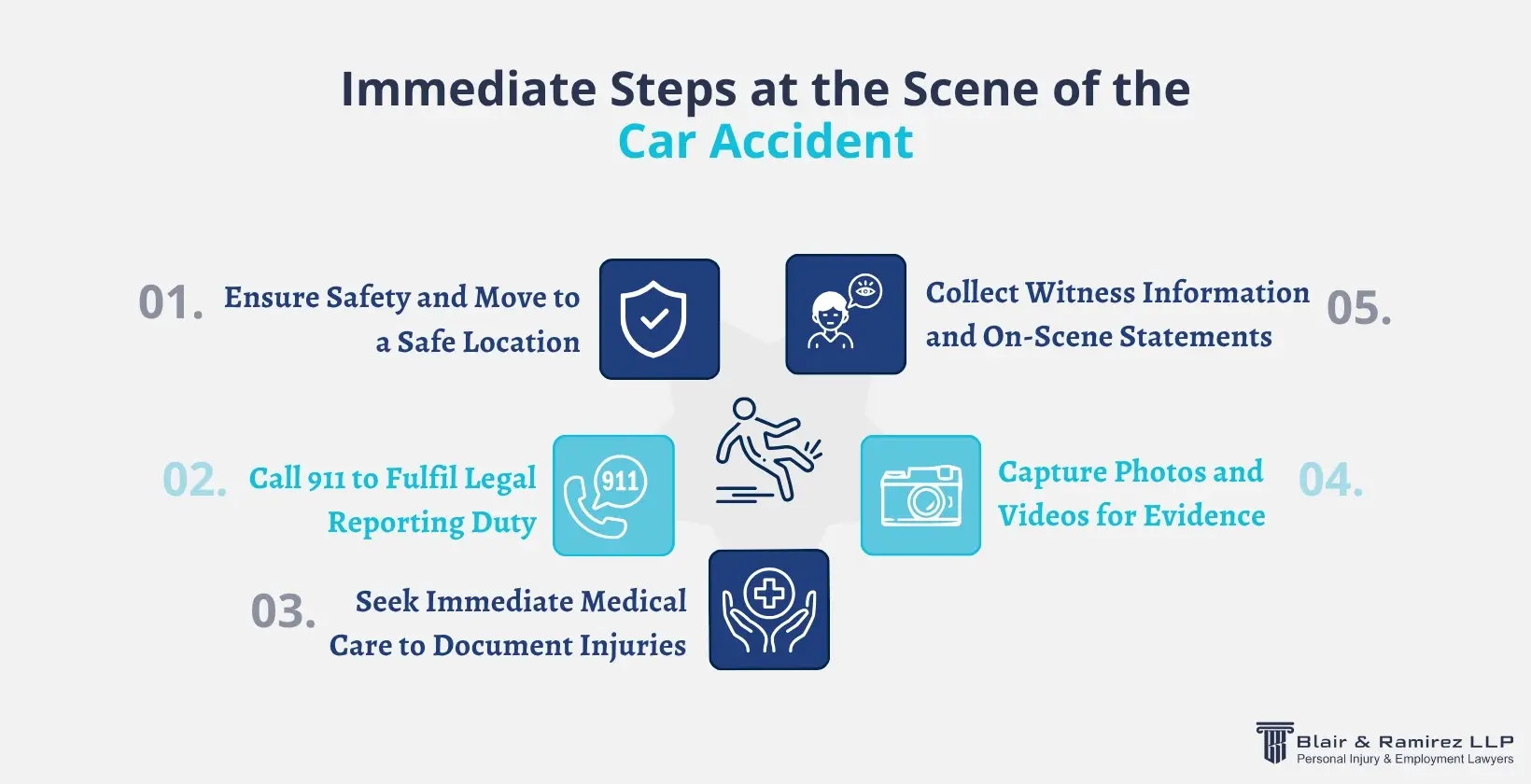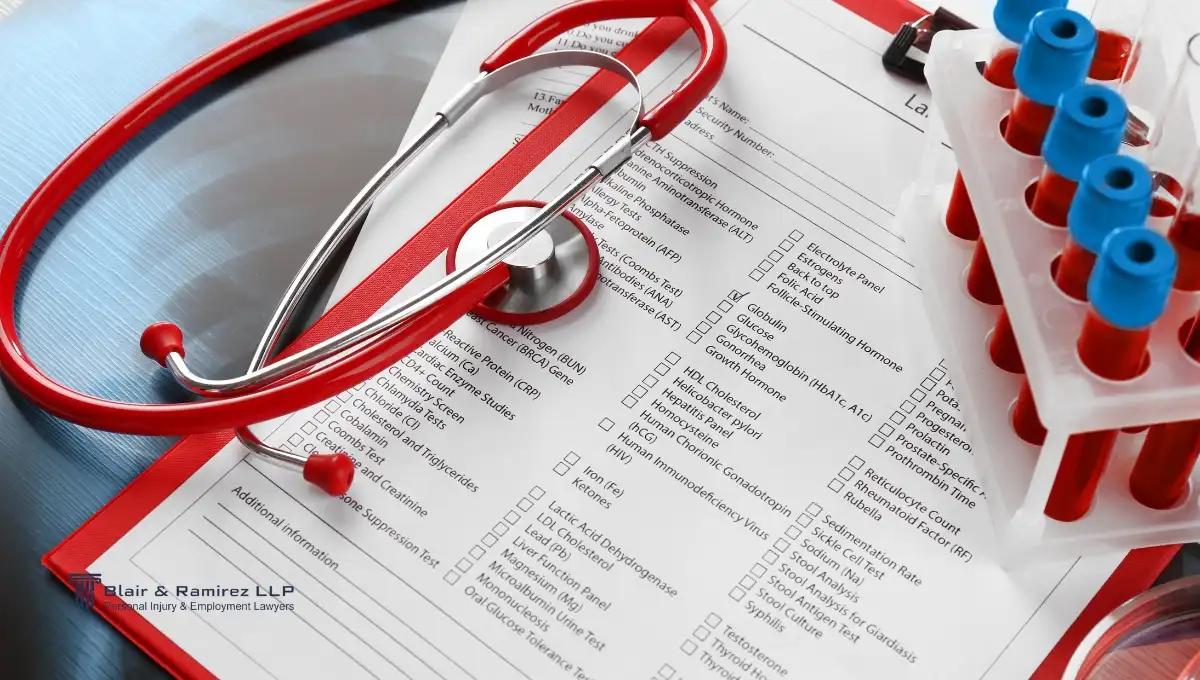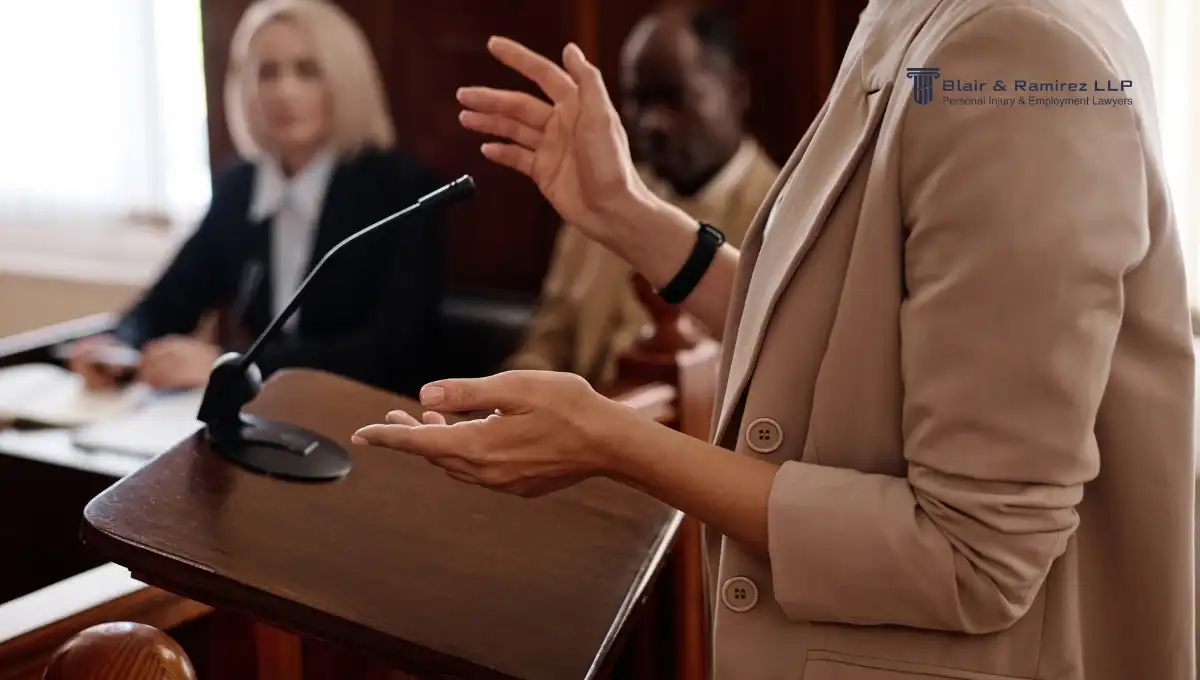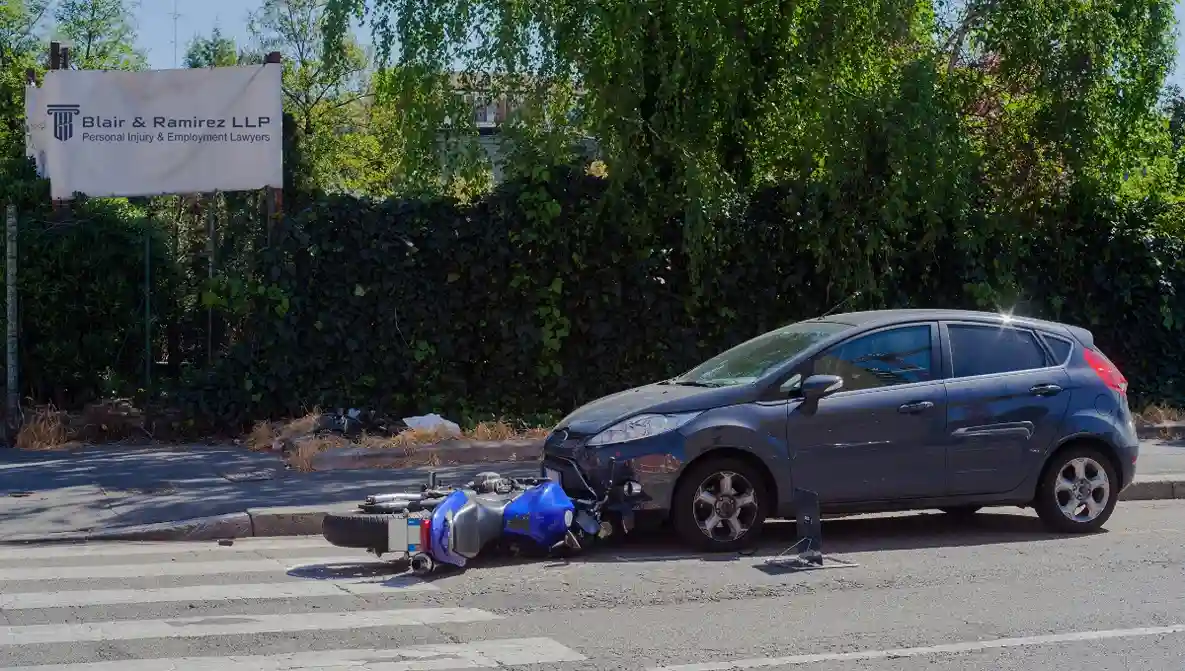Every second after a crash counts. What you do after a car accident could make or break your case. From preserving evidence to dealing with insurance adjusters, your actions matter, and in California, your legal rights start the moment the accident occurs.
At Blair & Ramirez LLP, our experienced car accident lawyers help you take control from day one. We’ll preserve critical evidence, handle the insurance companies, and guide you step-by-step, so you can focus on recovery while we fight for the compensation you deserve.
We work on a contingency-fee basis, meaning you pay nothing unless we win your case. With fast support, honest answers, and a track record of proven results, we’re here when it matters most.
Call now for a free consultation and take the first step toward protecting your full compensation.
Key Takeaways From the Blog
- Act fast after a crash. Move to a safe location, call 911, and document the scene to protect your legal rights.
- File all required reports. Submit the California SR-1 form within 10 days if anyone was injured or the damage exceeds $1000.
- Seek medical care immediately. Delays make it harder to prove your injuries are related to the crash.
- Do not admit fault. Report the accident factually to your insurance company and let your lawyer speak on your behalf.
- Hiring a lawyer increases compensation. Victims with legal representation recover 3–5 times more in California injury claims.
- Blair & Ramirez LLP charges no upfront fees. You only pay if we win your car accident case.

Immediate Steps at the Scene of the Accident
What you do in the first 15 minutes after a car accident in California directly impacts your safety, legal rights, and future claim. Mistakes at the scene can lower your compensation or trigger legal consequences.
Here is what to do after a car accident to protect your safety and strengthen your case.

1. Ensure Safety and Move to a Safe Location
Under California law, you have a legal obligation to stop at the scene of any accident involving property damage or injury. Failing to stop, even in a minor crash can result in criminal hit-and-run charges. First, check yourself and others for injuries. If it’s safe and your vehicle is drivable, move to a secure location nearby to avoid further danger. Taking these steps protects you from further harm and ensures you remain in full compliance with the law.
2. Call 911 to Fulfil Legal Reporting Duty
3. Seek Immediate Medical Care to Document Injuries
Always accept medical attention at the scene and follow up with a doctor within 24 hours, even if you feel okay. Some injuries, like concussions, internal bleeding, or soft tissue damage, may not show symptoms right away. Delaying treatment can not only put your health at risk but also weaken your legal claim.
Why prompt medical care is critical:
- Paramedic and hospital records establish a direct link between the crash and your injuries.
- Diagnostic tests and physician assessments document the full extent of harm.
- These records become key evidence when calculating your compensation.
Getting checked early shows that you took the crash seriously and helps ensure no injury goes unnoticed or undocumented.
4. Capture Photos and Videos for Evidence
Photo and video proof is critical after a car accident. Insurance adjusters and lawyers use this media to evaluate fault, damage, and conditions.
What to photograph or film:
- Each vehicle from multiple angles (including license plates).
- Damage to property (guardrails, signs, etc.).
- Road conditions: debris, potholes, skid marks.
- Injuries: bruises, cuts, and airbag deployment.
- Traffic signals or signs.
Use your smartphone’s timestamp. Take wide shots and close-ups. Use flash or headlights in poor lighting.
5. Collect Witness Information and On-Scene Statements
If anyone saw the crash happen, calmly ask for their name, contact details, and a short description of what they observed. Witnesses play a crucial role in proving fault, especially if the other driver gives a conflicting story.
Tips to gather helpful statements:
- Be respectful and quick, people may be in a rush.
- Record their statement on your phone (with their permission).
- Note key details like what they saw, where they were standing, and what direction the vehicles were going.
These neutral, third-party accounts can carry significant weight with both insurance companies and in court, strengthening your version of events.
Legal Compliance and Documentation After a Car Accident
After a car accident in California, meeting legal requirements is not optional; it is essential for protecting your claim. Missing a deadline or skipping a required report can lower your compensation or even risk license suspension.
Here is what to file, document, and organise after a crash.
File a Traffic Collision Report (SR-1) with the California DMV
Notify Your Insurance Without Admitting Fault
You are legally required to report the crash to your insurer, regardless of fault. Avoid saying “I am sorry” or “It was my fault.” Use languages like: “I was involved in a collision and am reporting as required.” Admitting fault too early can undermine your claim, even if you are not legally responsible. Let your attorney speak on your behalf if questions go beyond basic facts.
Contact a Car Accident Lawyer Before Filing a Claim
Speaking with an attorney early helps protect your rights. An experienced car accident lawyer can:
- Preserve key evidence before it disappears.
- Communicate with adjusters to prevent manipulation.
- Maximise your compensation based on California injury law.
- Guide you through legal paperwork with precision.
The earlier you get legal help, the stronger your case will be.
If you're facing issues in the Los Angeles area, Blair & Ramirez Law's Los Angeles car accident attorneys could help you.
Organize Medical Records, Photos, and Witness Statements
A well-organized legal file strengthens your case during negotiations and increases the chances of maximum compensation. Include:
- Medical records and treatment plans.
- Photos and video from the scene.
- Witness names and contact details.
- Repair estimates and receipts.
- Proof of missed work and lost wages.
- Any correspondence with insurers.
Keeping everything in one place supports your claim and saves time when filing.

Keep a Personal Injury Journal to Track Recovery
A detailed personal injury journal can show how the injury affects your life and help increase compensation for pain and suffering.
Write down:
- Daily pain ratings (1–10).
- Mental health effects (stress, anxiety, sleep).
- Physical limitations (walking, lifting, driving).
- Medication responses and side effects.
Navigating the Car Accident Claim Process in California
Filing a car accident claim in California involves more than just paperwork; it is a complex legal process with significant financial consequences. Delays, missing evidence, or misunderstandings about fault can cost you thousands.
Early legal help ensures every step is handled correctly, from reporting the crash to collecting your final settlement.
Determine Fault Under California’s Comparative Negligence Rule
California uses a comparative negligence system, which means each party involved in a crash is assigned a percentage of fault. If you're found partially at fault, your compensation will be reduced accordingly. For instance, if your damages total $100,000 and you're 20% at fault, you'll receive $80,000.
However, if you are not found at fault, in that case, you are entitled to recover the full amount of your losses: medical bills, lost wages, vehicle damage, and pain and suffering, without any deductions.
Insurance companies often try to shift the blame to reduce their payout. A skilled California car accident lawyer will fight to ensure you're not unfairly blamed and help you pursue the maximum compensation you’re legally owed.
Initiate Your Insurance Claim Promptly
California law does not have a specific deadline for notifying your insurer; however, most policies require reporting within 24 to 72 hours after a crash. Waiting too long can result in denial or reduced payout. Prepare your police report, photos, medical bills, and witness info before contacting the insurer. Quick action helps show you are serious and organized.
Submit Supporting Evidence for Your Claim
Stronger evidence leads to higher compensation. Make sure to gather:
- Police report for crash details.
- Medical records to show treatment and severity.
- Photos/videos to prove vehicle and scene conditions.
- Witness statements to verify events.
Solid documentation gives your lawyer the leverage during settlement negotiations or trial.
Calculate Compensation for Medical, Wage, and Property Damages
Your personal injury claim can include multiple damage categories:
| Type of Damage | What It Covers |
|---|---|
| Medical Expenses | ER visits, surgery, and physical therapy |
| Lost Wages | Missed work, reduced hours |
| Property Damage | Car repairs, phone, and tools |
| Pain and Suffering | Chronic pain, PTSD, and emotional distress |
| Loss of Earning Capacity | Inability to return to previous work |
Note that each damages must be backed by bills, pay stubs, doctor’s notes, or expert opinions.
Negotiate a Settlement with Insurance Adjusters
Settlement talks are not casual conversations; they are strategic legal negotiations. Insurance adjusters offer lowball settlements, delay communication, or try to shift blame.
Your lawyer counters this with a demand letter backed by strong evidence. A demand letter explains your losses, asserts your legal rights, and starts formal negotiations. The goal is a fair payout, not a quick one.
Beyond the settlement amount itself, you should understand the tax implications of a car accident settlement, as this can influence your overall recovery.
Understand the Role of a Demand Letter
A demand letter is a legal document your lawyer sends to the insurer. It includes:
- A summary of the accident
- Medical treatment and injury details
- Who is at fault and why
- Total compensation demanded
- A response deadline
This letter puts pressure on the insurer to settle or prepare for court.
Prepare for Trial If Settlement Fails
If negotiations stall, your case may go to trial. Your legal team will:
- File the lawsuit
- Complete discovery (evidence exchange)
- Present witnesses and expert testimony
- Argue your case in court
Trial adds time and costs, but can result in higher payouts, especially if the insurer acted in bad faith.

Track Legal Deadlines for Filing a Claim
California has strict filing deadlines:
- 2 years for injury claims.
- 3 years for property damage.
- 6 months for government vehicle-related accidents (with early notice required).
If your injuries appear later, the discovery rule gives you 1 year from the date you knew to file. Missing any deadline means losing your right to compensation.
Special Claim Scenarios in California Car Accidents
Not every crash fits the usual mold. Accidents involving uninsured drivers, hit-and-runs, Uber or Lyft vehicles, or out-of-state drivers come with unique legal hurdles. These cases often involve complex insurance rules, unclear liability, and tighter deadlines. If your accident falls into one of these categories, having an experienced attorney on your side can make all the difference in protecting your rights and securing the compensation you deserve.
What to Do If the Other Driver Is Uninsured or Underinsured
If the at-fault driver has no insurance or too little to cover your damages, you may still be able to recover compensation through your own Uninsured/Underinsured Motorist (UM/UIM) coverage. This protection is included in many California auto policies and can step in to cover medical bills, lost wages, and other losses when the other driver can't pay.
How to file a UM/UIM claim in California:
- Notify your insurer right away once you learn the other driver is uninsured or underinsured.
- Submit supporting documentation such as police reports, medical records, repair estimates, and photos.
- Be prepared for pushback. Even your own insurer may try to minimize your payout, treat them as you would any opposing party.
- You may have the option to sue the uninsured driver personally, but collecting from someone without assets is often difficult. An experienced attorney can help enforce your UM/UIM rights and avoid delays or denials.
| Key Factors | Insured Driver | Uninsured Driver |
|---|---|---|
| Liability Coverage | Paid by their insurance | Covered under your UM/UIM policy. |
| Claim Process | File a third-party claim | File a first-party claim with your insurer. |
| Legal Complexity | Lower | Higher – your insurer becomes your opponent. |
| Chance of Recovery | Higher | Depends on your own policy limits. |
What To Do After a Minor Car Accident or Fender Bender
Don’t let the word “minor” fool you. Low-speed collisions can still lead to costly repairs and hidden injuries. Treat every crash seriously to protect your health and your legal rights.
- Photograph everything: Capture damage to all vehicles, road conditions, skid marks, and surroundings.
- Call the police: Request an official report, even if no one appears seriously injured.
- Get medical care: Visit a doctor to check for delayed injuries like whiplash or soft tissue damage.
- Document thoroughly: Keep all records, from medical visits to repair estimates.
Insurance companies often downplay minor accidents. Proper documentation ensures you’re protected if pain or symptoms develop days later.

What to Do After a Hit-and-Run Accident
When the at-fault driver flees the scene, you must act quickly to protect your health, your rights, and your ability to recover compensation through youruninsured motorist (UM) coverage.
Steps to take after a hit-and-run in California:
- Call 911 immediately to report the accident and request emergency assistance.
- File a police report on the spot. This is critical evidence for your UM claim.
- Submit a Traffic Collision Report (SR-1) to the DMV if there’s over $1,000 in damage or anyone is injured.
- Notify your insurance company and start a UM claim right away.
- Share all details about the fleeing driver or vehicle, license plate, make/model, direction of travel, or anything you remember.
Fast action strengthens your case, improves the chances of identifying the driver, and increases the likelihood that your insurance provider will approve your claim.
Claim Process for Rideshare Accidents (Uber/Lyft)
Rideshare accidents involve unique insurance rules based on the driver’s activity at the time of the crash. Uber and Lyft provide tiered coverage that changes depending on whether the app is on and if a ride has been accepted.
| Driver Status | Primary Insurance | Coverage Limits |
|---|---|---|
| App Off | Driver’s personal auto insurance | Minimum California limits |
| App On, No Ride Accepted | Uber/Lyft contingent liability coverage | $50k/$100k injury, $25k property damage |
| Ride Accepted to Drop-off | Uber/Lyft commercial policy | Up to $1 million in third-party liability coverage |
It’s not always clear which policy applies, or whether multiple parties share liability. A rideshare accident lawyer can determine the correct coverage tier, file claims accordingly, and make sure you don’t miss out on compensation due to confusing policy rules.
Accidents Involving Out-of-State Drivers or Tourists
When the at-fault driver is from another state but the crash happens in California, California law still governs the case. However, these accidents often bring added complications:
- The out-of-state driver may carry lower insurance limits than required in California.
- Jurisdictional issues can arise when determining where the claim or lawsuit should be filed.
- Venue choices may impact the outcome based on local court procedures and jury tendencies.
A skilled California car accident attorney ensures your claim complies with state law while handling insurance policy differences and legal obstacles across state lines.
What Happens When the At-Fault Driver Is a Minor
If the at-fault driver is under 18, you still have legal pathways to pursue compensation. In California, parents or legal guardians are typically held financially responsible through their insurance coverage.
Common Compensation Sources:
- Parent’s Auto Insurance: Most family policies extend coverage to licensed minors.
- Umbrella Policies: Additional coverage may apply in high-value cases.
- Civil Lawsuits: In severe accidents, you may sue the parents for negligent supervision or entrustment.
The legal approach depends on the minor’s age, driving status, and license type. An experienced attorney will assess your options and pursue the strongest route to full recovery.
How to Protect the Value of Your Injury Claim
Even strong car accident claims lose value when victims make avoidable mistakes. To protect your claim, take quick action, follow medical advice, and avoid giving insurers any excuse to underpay.
Here is how to protect your compensation after a crash in California.
Avoid Social Media Posts That Hurt Your Claim
Insurance companies actively monitor your social media activity after a crash. A single photo of you smiling, exercising, or enjoying a trip can be misused to argue that your injuries aren’t serious. Even your lighthearted jokes or vague comments may be taken out of context.
To protect your credibility and strengthen your case, it's best to stay off social media entirely until your claim is resolved or your case goes to trial. Let your recovery, and your legal team speak for you.
Follow All Medical and Legal Instructions Consistently
Missed doctor visits or skipped physical therapy weaken your case. Gaps in care suggest your injuries are not serious. Likewise, missing legal steps or deadlines can damage your claim.
Show that you are serious: follow every medical and legal instruction carefully.
Comparison Table: With vs. Without Legal Help:
| Action | With a Lawyer | Without a Lawyer |
|---|---|---|
| Medical Referrals | Coordinated with trusted specialists. | You choose providers alone. |
| Evidence Handling | Preserved early and correctly. | Often incomplete or missing. |
| Insurance Negotiation | Based on full legal valuation. | Based on what the insurer offers. |
| Communication with Insurers | Handled by the legal team. | Handled directly, with risk of missteps. |
| Legal Deadlines | Tracked and managed by your legal team. | Often missed or misunderstood. |
Do Not Delay Reporting Symptoms or Updates to Providers
Pain that appears days after a crash must still be documented. If you wait to report symptoms, insurers may claim they are unrelated. Tell your doctor about every symptom, no matter how small, and update them regularly.
Decline Lowball Offers Without Full Damage Assessment
Quick settlement offers often come before you know the full cost of your injury.
Warning signs of a lowball offer:
- Pressure to accept right away.
- Missing compensation for pain and suffering.
- No estimate for future medical care or wage loss.
Before you say yes:
- Get a full medical evaluation.
- Collect repair estimates and wage loss proof.
- Talk to a car accident lawyer about what your claim is truly worth.
A lawyer helps calculate the full value, not just what the insurer offers.
How Legal Representation Impacts Your Case
Why Hiring a California Car Accident Lawyer Improves Your Claim Outcome
Hiring a California car accident lawyer gives you a major advantage. Studies show that injured victims with lawyers recover 3 to 5 times more than those without legal help.
An attorney will:
- Collect and organise your evidence.
- Handle all communication with insurance companies.
- Accurately value your injuries and losses.
- Build a case designed to win at settlement or trial.
Without legal representation, you may miss key damages or fall for insurer tactics.
Why Experience Matters in California Personal Injury Law
Every state has different rules. A lawyer experienced in California personal injury law knows how to handle insurance companies, local courts, and state-specific deadlines.
Our team knows:
- How local judges interpret injury claims.
- What adjusters use to deny or reduce offers.
- How to file all forms without delay or error.
Experience increases your odds of success and your payout.
Why Blair & Ramirez LLP Is the Right Firm for Your Case
Blair & Ramirez LLP focuses on serious car accident claims in California.
Our lawyers have:
- Recovered millions for injury victims.
- Won tough cases through negotiation and trial.
- Maintained 5-star client satisfaction across platforms.
We handle your entire case with aggressive communication, top-tier strategy, and no upfront fees. You pay nothing unless we win.
Schedule a Free Consultation With a California Car Accident Lawyer
If you were injured in a California car accident, talk to a lawyer before time runs out. Waiting too long can cost you evidence, leverage, and compensation.
Our experienced car accident lawyers offer free consultations to help you understand your legal rights, protect your evidence, and take immediate action before deadlines pass or insurers gain the upper hand.

You pay nothing unless we win your case. Call 213-395-9791 or fill out our contact form to schedule your free case review.
Tell Us What Happened - We’re Ready to Help


